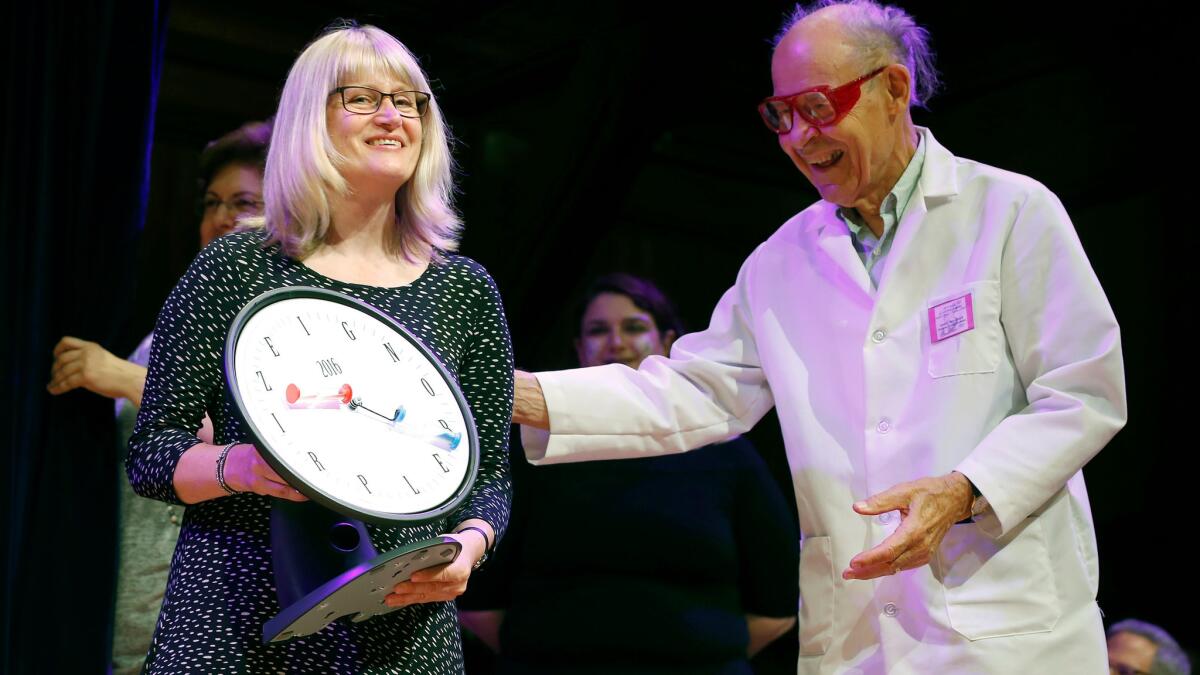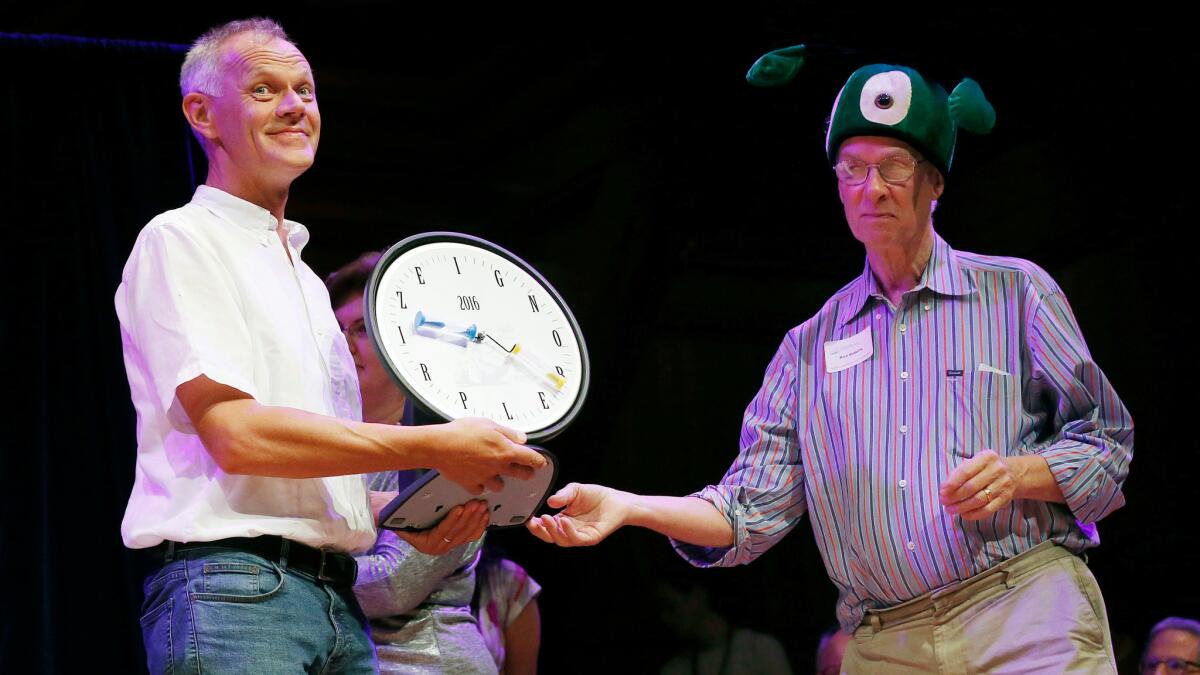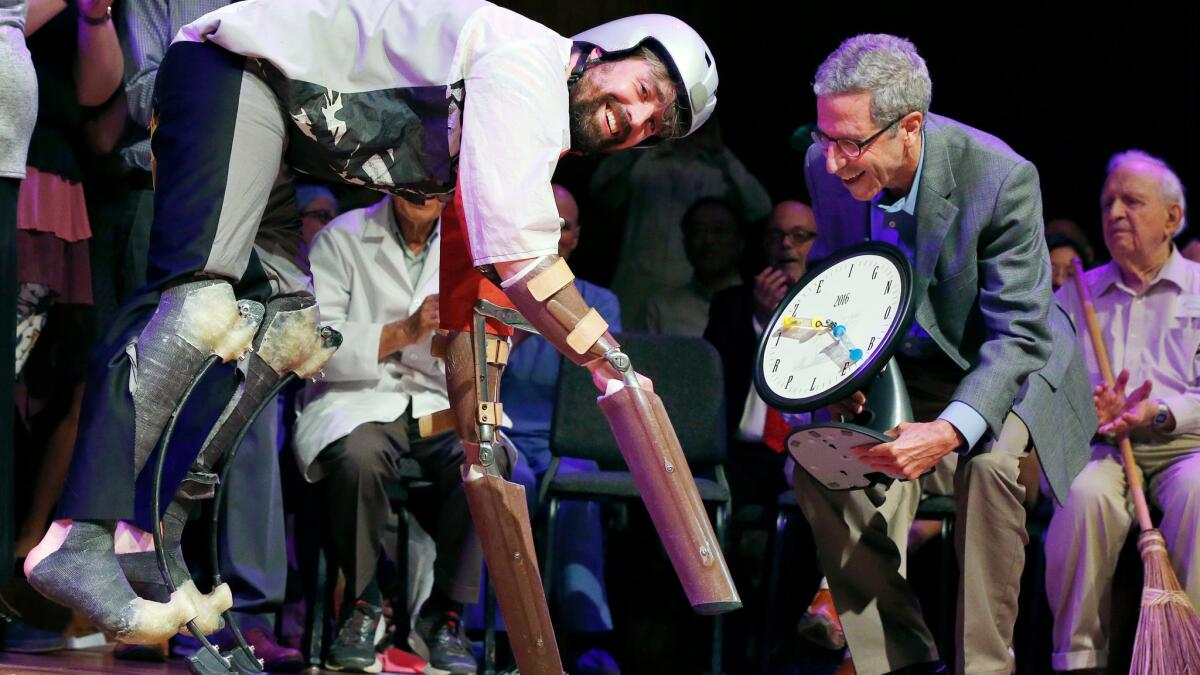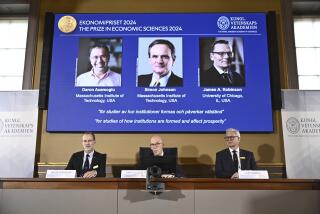Studies on the perils of polyester underwear and the personality of rocks win Ig Nobel Prizes

10 winners from five continents were celebrated at the annual show for studies in fields ranging from physics to neuroscience.
Not every scientific study can be about weighty topics, like gravity waves or gene editing. Sometimes you can gain a true scientific insight by discovering that mammals of vastly different sizes require roughly the same amount of time to empty their bladders, or by noticing that people who speak 10 disparate languages all came up with a version of the word “huh.”
That’s why we celebrate the Ig Nobel Prizes.
These awards are bestowed every fall by the editors of the Annals of Improbable Research. There are 10 winners in a range of categories, which typically include fields such as physics, neuroscience and mathematics (but which also may include entomology, safety engineering or acoustics).
The prize-winning scholarship may sound silly, but that doesn’t mean it’s trivial. On the contrary, said Ig Nobel Master of Ceremonies Marc Abrahams, “Every winner has done something that first makes people laugh, then makes people think.”
It’s clear that winners are more flattered than offended. This year, they flew in from five continents (at their own expense) to pick up their awards: a clock with 61 seconds, a 10-trillion-dollar bill from Zimbabwe, and a handshake from Nobel laureates Roy Glauber (physics, 2005), Dudley Herschbach (chemistry, 1986), Eric Maskin (economics, 2007) and Richard Roberts (physiology or medicine, 1993).
The ceremony, at Harvard University’s Sanders Theater, also featured a “mini-opera,” very short lectures on such topics as fluid dynamics, a few “moments of science,” a tic-tac-toe tournament and the customary tossing of paper airplanes.
Here’s the complete list of this year’s winners:
REPRODUCTION: Forget Viagra. Men who have trouble in the bedroom might be able to solve their problem with a new pair of underwear. The late Ahmed Shafik from Cairo University’s Department of Surgery and Experimental Research discovered that polyester-containing undergarments significantly reduced the sexual success of male rats. In his experiments, rats forced to wear 100% polyester underwear for an entire year were 87% less likely to complete an attempted sexual encounter than they were in their pre-underwear days. Rats that donned underpants made from a 50-50 cotton-polyester blend saw their success rate fall by 71%. All of the rats saw their sex lives return to normal six months after ditching the trousers. Apparently, the problem with polyester was that it generated an electrostatic potential in the genital area — an average of 443 volts per square centimeter for rats wearing 100% polyester and 239 volts per square centimeter for rats in the hybrid fabric. All-cotton and all-wool garments had no measurable effect. The results were published in the journal European Urology in 1993. (Be sure to check Figure 1 on page 2 of the study.)
ECONOMICS: This award goes to a trio of researchers who showed that a smooth, dark rock has personality traits distinct from those of a lighter, more rugged rock. If you think that sounds bogus, you’re in good company — the researchers didn’t buy it, either. By asking people to ascribe personality traits to inanimate objects, they highlighted the flaws of a controversial marketing tool known as the Brand Personality Five-Factor Model. Their study was published in 2014 in the journal Marketing Theory.
PHYSICS: Some insects are drawn to sources of horizontally polarized light, which is more likely to emanate from dark objects than from light ones. This explains why five species of dragonflies are attracted to gravestones that are black, flat and shiny (like the surface of water) and why disease-carrying tabanid flies tend to leave white horses alone. Two separate research groups earned the physics prize for figuring this out. Their work appeared in the journals Freshwater Biology and Proceedings of the Royal Society B.

CHEMISTRY: Few people have lauded the engineers at Volkswagen for turning the company’s pollution-spewing cars into (allegedly) “clean diesel” vehicles, but their feat earned them a tongue-in-cheek Ig Nobel. The German automaker came up with software that allowed its cars to perform in a low-emissions mode when being tested but emit illegal amounts of nitrogen oxide when on the road. The U.S. Environmental Protection Agency and the California Air Resources Board exposed the scandal in 2015.
MEDICINE: This award goes to a team from the University of Luebeck in Germany that proved that you can relieve an itch in your right arm by scratching your left arm – if you trick your brain into thinking you’re actually scratching your right arm. In a series of experiments, the researchers injected histamine dihydrochloride into the right arms of 20 volunteers. Then they used mirrors and video feeds to make it look like they were scratching volunteers’ itchy arms, when it fact they were scratching their unaffected left arms. As long as the volunteers were fooled, the itch was relieved (to some degree), according to a 2013 study in PLOS One. The silly-seeming experiment could have practical benefits for people with itchy skin diseases that would be worsened by scratching.

PSYCHOLOGY: How should scientist conduct research on lying? This group of winners decided to ask 1,005 people (ages 6 through 77) how often they lied in the past 24 hours, and who was on the receiving end of their fibs. Their answers — which may or may not have been truthful — indicated that young adults were the best liars, and that people lied most frequently during their teenage years. Combined with the results of computer tests, the researchers concluded that lying varies with age – and that people studying deception should include subjects from across the age spectrum instead of relying too much on college students. The study appeared in Acta Psychologica in 2015.
PEACE: What makes some people believe seemingly profound but actually meaningless statements, such as “Perceptual reality transcends subtle truth” and “Nature is a self-regulating ecosystem of awareness”? Leave it to Canadians to ask this essential question. With the help of selected tweets from Deepak Chopra’s Twitter account, researchers from the University of Waterloo and Sheridan College identified certain traits that made people more susceptible to B.S. They included religious or paranormal beliefs, an embrace of alternative medicine, an interest in conspiracy theories and lower “cognitive ability.” Their treatise (with an awesome title we can’t print here) was published last year in the journal Judgment and Decision Making.
BIOLOGY: Sometimes, being human isn’t all it’s cracked up to be. To see what it’s like to be something else, lawyer/bioethicist/veterinarian Charles Foster tried to live as other kinds of animals, including a badger, a fox and a bird. For these exercises, he made himself temporary homes in the dirt, ate worms and learned to navigate by smell alone. He recounts his experiences in his new book, “Being a Beast.” Foster shares the award with Thomas Thwaites, who “took a holiday from being human” and lived on all fours with goats instead. He even developed a prosthetic rumen so he could eat grass with his new companions. His book is called “GoatMan.”

LITERATURE: What’s it like to collect hoverflies on a remote Swedish island? Entomologist Fredrik Sjoberg tells you everything you’d ever want to know in his memoir, “The Fly Trap.” The Ig Nobel committee lauded the book for describing “the pleasures of collecting flies that are dead, and flies that are not yet dead.”
PERCEPTION: It’s well-known that the world looks different when you’re upside-down, and that includes depth perception. Japanese researchers Atsuki Higashiyama of Ritsumeikan University in Kyoto and Kohei Adachi of Osaka University wanted to know why, so they got 15 volunteers to bend over and judge the distance of five objects while looking through their legs. They compared the results to guesses made by volunteers who were standing upright but wearing goggles that flipped everything they saw 180 degrees. The results, published in Vision Research in 2006, bolstered a theory known as the direct perception model.

Abrahams, editor of the Annals of Improbable Research and master of ceremonies, closed the awards ceremony with his usual valediction: “If you didn’t win an Ig Nobel Prize tonight — and especially if you did — better luck next year.”
Sorry you missed it? You can catch a recap on NPR’s “Science Friday” program the day after Thanksgiving.
Follow me on Twitter @LATkarenkaplan and “like” Los Angeles Times Science & Health on Facebook.
MORE IN SCIENCE
MacArthur winner Victoria Orphan showed how deep-sea microbes keep greenhouse gas out of atmosphere
Manu Prakash, newly minted MacArthur ‘genius,’ builds water computers and origami microscopes
UPDATES:
6:45 p.m.: This story has been updated to include a full list of winners and some details from the ceremony.
The story was originally published at 2:30 p.m.







